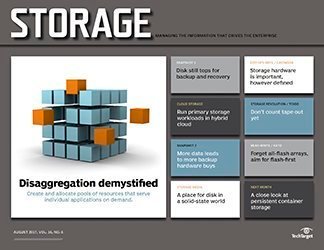PRO+ Premium Content/Storage
Access your Pro+ Content below.
Disaggregating network, compute and storage allocation demystified

This article is part of the Storage issue of August 2017, Vol. 16, No. 6
The time spent supporting aging IT architectures is orthogonal to the needs of today's fast-paced business environments. Granted, several newer technologies, such as converged and hyper-converged infrastructures, public and private clouds, and Hadoop- and Spark-based scale-out products and services are easing the situation. It's not enough, however. We want to spend more time developing new applications and little to no time managing IT infrastructures. Enter disaggregation. Separating an aggregate into its components isn't a new concept, but this approach is assuming greater importance. For IT, disaggregation means breaking a computer down to its core elements -- compute, memory, I/O, storage, cache, network fabric and so on -- to implement more-cost-effective, agile infrastructures and more-efficient storage allocation. But why do this now after a decade of aggregating IT resources through concepts like hyper-convergence? Scaling resources individually is often more-cost-effective than scaling them as combinations. The idea of...
Features in this issue
-
Disaggregating network, compute and storage allocation demystified
Explore the ways disaggregation concepts and principles are being applied to create and allocate pools of compute and storage resources to serve applications on demand.
-
Hybrid cloud technology gets the most out of primary storage workloads
Learn what to look for in a hybrid cloud platform so you can take advantage of the scalability, agility and cost benefits it has to offer primary storage.
Columns in this issue
-
Software-defined storage products don't negate hardware's importance
Software-defined storage, positioned as the cure-all for vendor lock-in, suggests that hardware may not be as important to IT infrastructure as it once was.
-
Forget all-flash arrays, aim for flash-optimized storage first
Look for simple, cost-effective products that are optimized for flash and meet your needs rather than focusing on the all-flash array storage that vendors are pushing.
